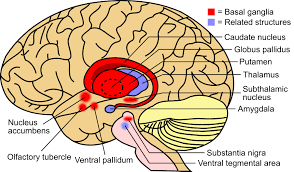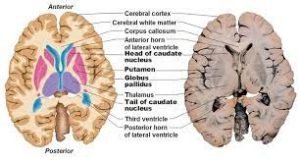
 The putamen is a round structure located at the base of the forebrain.
The putamen is a round structure located at the base of the forebrain.
The putamen and caudate nucleus together form the dorsal striatum.
It is also one of the structures that compose the basal nuclei.
The putamen is connected to the substantia nigra, the globus pallidus, the claustrum, and the thalamus, in addition to many regions of the cerebral cortex.
A primary function of the putamen is to regulate movements at various stages: preparation and execution, and to influence various types of learning.
It employs GABA, acetylcholine, and enkephalin to perform its functions.
The putamen also plays a role in degenerative neurological disorders, such as Parkinson’s disease.
Along with the caudate nucleus it forms the dorsal striatum.
The caudate and putamen contain the same types of neurons and circuits.
Some consider the dorsal striatum to be a single structure, divided into two parts by a large fiber tract, the internal capsule, passing through the middle.
The lentiform nucleus is made up of the putamen, together with the globus pallidus.
The putamen is the outermost portion of the basal ganglia.
The basal ganglia is a group of nuclei in the brain that are interconnected with the cerebral cortex, thalamus, and brainstem.
Basal ganglia include the dorsal striatum, substantia nigra, nucleus accumbens, and the subthalamic nucleus.
The basal ganglia are associated with motor control, cognition, emotions, learning, and domain-general functions important for executive functioning as well as support for domain-specific languages.
The basal ganglia are located bilaterally, and have rostral and caudal divisions.
The putamen is located in the rostral division as part of the striatum.
The basal ganglia receive input from the cerebral cortex, via the striatum.
The putamen is interconnected with the following structures:
The striatum includes the caudate nucleus and putamen and the globus pallidus.
The cortico-subcortico-cortical circuits with putaminal involvement are dense and complicated, consisting of a wide range of axonal, dendritic, chemical, afferent, and efferent substrates.
The caudate works with the putamen to receive the input from cerebral cortex, and is considered the entrance to the basal ganglia.
Projections from the putamen reach the caudate directly, and the putamen and caudate are jointly connected with the substantia nigra.
The caudate outputs more densely to the substantia nigra pars reticulata while the putamen sends more afferents to the internal globus pallidus.
The substantia nigra contains two parts: the substantia nigra pars compacta (SNpc) and the substantia nigra pars reticulata (SNpr).
The SNpc obtains input from the putamen and caudate, and sends information back.
The SNpr also obtains input from the putamen and caudate.
The substantia nigra sends the input outside the basal ganglia to control head and eye movements.
The SNpc produces dopamine, which is crucial for movements.
The SNpc is the part that degenerates during Parkinson’s disease.
The globus pallidus contains two parts: the globus pallidus pars externa (GPe) and the globus pallidus pars interna (GPi).
Both regions acquire input from the putamen and caudate and communicate with the subthalamic nucleus.
However, mostly the GPi sends GABAergic inhibitory output to the thalamus.
The GPi also sends projections to parts of the midbrain, which have been assumed to affect posture control.
The putamen and striatum have numerous circuits that allow for cortico-subcortico-cortico communication loops.
GABAergic projections of the putamen have an inhibitory effect on the thalamus, and conversely thalamic projections from the centromedian and parafascicular nuclei have an excitatory effect on the putamen.
Dopamine is a neurotransmitter that has a dominant role in the putamen, most of it is supplied from the substantia nigra.
When a cell body of a neuron in the putamen or caudate nuclei fires an action potential, it releases dopamine from the presynaptic terminal.
The putamen and caudate nuclei modulate the dendrites of the substantia nigra, and the dopamine released influences the substantia nigra, which affects motor planning.
The putamen also plays a role in modulation of other neurotransmitters: releasing GABA, enkephalin, substance P, and acetylcholine.
Pylorus receives serotonin and glutamate.
The putamen is interconnected with many other structures, and influences many types of motor behaviors: motor planning, learning, and execution, motor preparation, specifying amplitudes of movement,and movement sequences.
The putamen affects movement but it also shows that it integrates with other structures in order to perform tasks.
The bputamen plays a role in many types of learning.
Along with various types of movement, the putamen also affects reinforcement learning and implicit learning.
Reinforcement learning refers to the interaction with the environment and modifying actions to maximize the outcome.
Implicit learning refers to the passive process where people are exposed to information and acquire knowledge through exposure.
Dopamine and tonically active neurons play a key role in acquiring knowledge.
The putamen apparently plays a role in the perception of contempt and disgust, and may be part of the motor system that’s mobilized to take action: the amount of activity in the hate circuit correlates with the amount of hate a person declares, which could have legal implications concerning malicious crimes.
The putamen was found to have significantly larger amounts of grey matter in male to female transgender individuals compared to the putamen of a typical cisgender man, suggesting a fundamental difference in brain composition may or may not exist between trans women and cisgender men.
The putamen and other parts of the basal ganglia play an important role in Parkinson’s disease and other diseases that involve the degeneration of neurons.
Parkinson’s disease is the slow and steady loss of dopaminergic neurons in substantia nigra pars compacta.
In Parkinson’s disease the putamen plays a key role because its inputs and outputs are interconnected to the substantia nigra and the globus pallidus.
In Parkinson’s disease the activity in pathways to the globus pallidus decreases and activity in indirect pathways to external globus pallidus increases.
Parkinson’s patients have a difficult time with motor planning.
Other diseases and disorders.
Diseases and disorders are linked with the putamen:
Cognitive decline in Alzheimer’s disease
Huntington’s disease
Wilson’s disease
Dementia with Lewy bodies
Corticobasal degeneration
Tourette syndrome
Schizophrenia
Depression
Attention deficit hyperactivity disorder
Chorea
Obsessive-Compulsive Disorder[
Kernicterus
The putamen, part of the basal ganglia and can be involved in hemiballismus due to the fact that it projects to the premotor cortex through the globus pallidus.
Damage to the putamen area can also cause hemiballistic movements to be seen as it is also part of the chain in movement.
